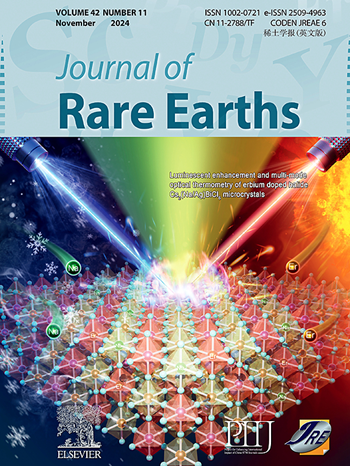Effective suppression of surface cation segregations on double perovskite oxides through entropy engineering
IF 7.2
1区 化学
Q1 CHEMISTRY, APPLIED
引用次数: 0
Abstract
Cation segregation on cathode surfaces plays a key role in determining the activity and operational stability of solid oxide fuel cells (SOFCs). The double perovskite oxide PrBa0.8Ca0.2Co2O5+δ (PBCC) has been widely studied as an active cathode but still suffer from serious detrimental segregations. To enhance the cathode stability, a PBCC derived A-site medium-entropy Pr0.6La0.1Nd0.1Sm0.1Gd0.1Ba0.8Ca0.2Co2O5+δ (ME-PBCC) oxide was prepared and its segregation behaviors were investigated under different conditions. Compared with initial PBCC oxide, the segregations of BaO and Co3O4 on the surface of ME-PBCC material are significantly suppressed, especially for Co3O4, which is attributed to its higher configuration entropy. Our results also confirm the improved electrochemical performance and structural stability of ME-PBCC material, enabling it as a promising cathode for SOFCs.

通过熵工程有效抑制双包晶氧化物表面阳离子偏析
阴极表面阳离子偏析对固体氧化物燃料电池(SOFCs)的活性和运行稳定性起着关键作用。双钙钛矿氧化物PrBa0.8Ca0.2Co2O5+δ (PBCC)作为活性阴极已被广泛研究,但仍存在严重的有害偏析。为了提高阴极的稳定性,制备了PBCC衍生的a位中熵Pr0.6La0.1Nd0.1Sm0.1Gd0.1Ba0.8Ca0.2Co2O5+δ (ME-PBCC)氧化物,并研究了其在不同条件下的偏析行为。与初始PBCC氧化物相比,ME-PBCC材料表面BaO和Co3O4的分离被明显抑制,特别是Co3O4,这归因于其更高的构型熵。我们的研究结果也证实了ME-PBCC材料的电化学性能和结构稳定性的改善,使其成为sofc的有前途的阴极。
本文章由计算机程序翻译,如有差异,请以英文原文为准。
求助全文
约1分钟内获得全文
求助全文
来源期刊

Journal of Rare Earths
化学-应用化学
CiteScore
8.70
自引率
14.30%
发文量
374
审稿时长
1.7 months
期刊介绍:
The Journal of Rare Earths reports studies on the 17 rare earth elements. It is a unique English-language learned journal that publishes works on various aspects of basic theory and applied science in the field of rare earths (RE). The journal accepts original high-quality original research papers and review articles with inventive content, and complete experimental data. It represents high academic standards and new progress in the RE field. Due to the advantage of abundant RE resources of China, the research on RE develops very actively, and papers on the latest progress in this field emerge every year. It is not only an important resource in which technicians publish and obtain their latest research results on RE, but also an important way of reflecting the updated progress in RE research field.
The Journal of Rare Earths covers all research and application of RE rare earths including spectroscopy, luminescence and phosphors, rare earth catalysis, magnetism and magnetic materials, advanced rare earth materials, RE chemistry & hydrometallurgy, RE metallography & pyrometallurgy, RE new materials, RE solid state physics & solid state chemistry, rare earth applications, RE analysis & test, RE geology & ore dressing, etc.
文献相关原料
公司名称
产品信息
阿拉丁
Ce(NO3)3·6H2O
阿拉丁
Co(NO3)2·6H2O
阿拉丁
Ca(NO3)2·4H2O
阿拉丁
Ba(NO3)2
阿拉丁
Gd(NO3)3·6H2O
阿拉丁
Sm(NO3)3·6H2O
阿拉丁
Nd(NO3)3·6H2O
阿拉丁
La(NO3)3·6H2O
阿拉丁
Pr(NO3)3·6H2O
阿拉丁
citric acid
阿拉丁
ethylenediaminetetraacetic acid (EDTA)
 求助内容:
求助内容: 应助结果提醒方式:
应助结果提醒方式:


